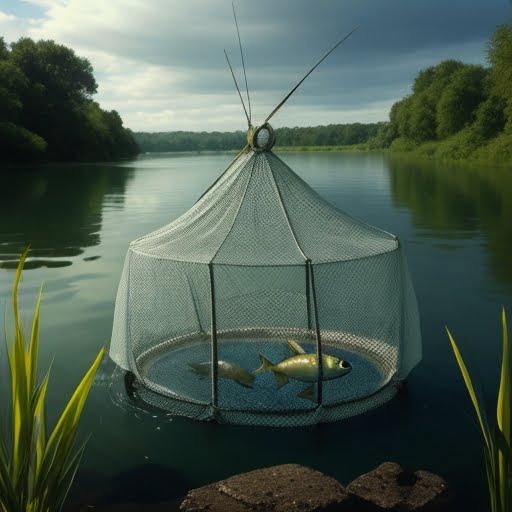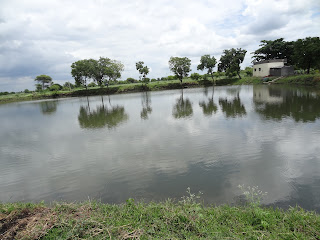Nursery Pond: A nursery pond, also known as a fish nursery or hatchery pond, is a controlled aquatic environment designed for the rearing and early development of young fish, shrimp, or other aquatic organisms before they are released into natural habitats or larger grow-out ponds. Nursery ponds are an integral part of aquaculture and fisheries management, as they help ensure the survival and growth of juvenile aquatic species in a protected environment.
Nursery Pond Management
Here are some key features and aspects of nursery ponds:
- Size and Design: Nursery ponds can vary in size, from small earthen ponds to larger, more complex facilities. The design of the pond includes considerations for water supply, drainage, and circulation to maintain suitable water quality and temperature for the growing juveniles.
- Water Quality Management: Proper water quality is essential for the health and growth of juvenile aquatic organisms. Parameters such as temperature, dissolved oxygen levels, pH, ammonia, and nitrate concentrations are closely monitored and managed to ensure optimal conditions.
- Feeding and Nutrition: Depending on the species being cultured, appropriate feed is provided to the juveniles to support their growth and development. Feed composition, feeding frequency, and feeding methods are tailored to the specific requirements of the species.
- Protection from Predators: Nursery ponds are often designed with measures to protect young fish from predators like birds, insects, and larger fish. This can include netting, fencing, or structures that deter predators from entering the pond.
- Health Management: Regular health assessments are conducted to identify and address any signs of disease or stress among the juvenile fish or shrimp. If necessary, treatments may be administered to maintain the health of the population.
- Weaning and Graduation: Depending on the growth and development of the juveniles, they may be gradually weaned off live or specialized feeds and transitioned to more appropriate diets for their size. Once they reach a suitable size, they can be moved to larger grow-out ponds or released into natural habitats.
- Species Selection: Different species have varying requirements for growth and development. Nursery ponds are often specialized for specific species to ensure that the environmental conditions and management practices meet their needs.
- Research and Conservation: Nursery ponds can also serve as research facilities for studying the growth, behavior, and physiology of juvenile aquatic organisms. Additionally, they can be used for conservation efforts, such as rearing endangered or threatened species before releasing them into the wild.
- Sustainable Practices: Many modern nursery ponds implement sustainable practices to minimize environmental impact, such as efficient water usage, nutrient management, and the use of renewable energy sources.
The ponds play a crucial role in supporting aquaculture production, restocking fisheries, and conserving aquatic biodiversity. They provide a controlled environment where young aquatic organisms can thrive, grow, and develop the resilience needed for successful survival in the wild or larger aquaculture systems.
Transport of fish fry
The newly hatched fries transported from hatching hapa to nursery pond are very tender so one should be very careful in maintaining them there. Nursery ponds should always be near the hatching hapas. The nursery ponds are small set of shallow (3′ to 5′ in depth) water reservoir. But now-a-day generally more deep (5′ to 8′) ponds are prepared having an area of about 1/2 acre. The ideal and recommended nursery ponds are 50 to 60′ x 30 to 40′ x 4 to 5′. The nursery ponds should be prepared before the hatching of fries. The exit and entrance of water should also be under control.
In nursery ponds natural resources of food are less and when large number of fries are released they certainly suffer due to lack of food. First of all predatory and weed fishes should be removed form pond. The chemical fertilizers viz ammonium sulphate, sodium nitrate and superphosphate should be used along with cowdung. The amount of chemical fertilizers should be less in quantity 5,000 to 70,000 kg cowdung/hectare is recommended in accordance with the nature and fertility of the pond soil. Due to these manures numerous zooplanktons are developed within 10 to 20 days and phytoplanktons are also grown up within 10 to 15 days. On these phyto-and zooplanktons they can feed easily and comfortably.
Mortality in nursery pond
The heavy mortality of fish fries has been recorded in nursery ponds. The following factors are responsible for such mortality:
(1) Sudden change in the quality of water form hatching hapa to nursery ponds.
(2) Lack of suitable food in pond.
(3) Presence of predatory fishes and predatory aquatic insects in the pond.
(4) Overgrowth of plankton.
(5) Decreased oxygen concentration in water.
(6) Cannibalism.
Precautions for nursery ponds
(1) In the nursery ponds water should be under good control and circulating.
(2) Pond should be nearer to the hatching ponds.
(3) Ponds should be predator free.
(4) To avoid the overcrowding, fries should be kept in limited number.
(5) Supply of food material should be proper. When fries are more developed in the nursery ponds and attain a length of 10 to 15 cm they should be transferred into the rearing ponds.
Transport of Fish Fry to Nursery Ponds
The fish fries are collected and transported to nurseries. In West Bengal these are transported in earthen ‘Hundies’ which cause heavy mortality due to the following factors.
(1) Decreased dissolved oxygen concentration in water.
(2) Increased carbon dioxide concentration in water.
(3) Toxicity of wastes like excreted ammonia.
(4) Hyperactivity and its strain.
(5) Physical injury to fries during transport.
To overcome the above mentioned injuries, fries are subjected to conditioning before transportation by keeping them into fixed volume of water for definite period and then transported in open or closed vessels. Temperature of the water of the vessels can be kept lower by tieing a wet cloth around the vessel. Dead fries should be removed to avoid the pollution and infections. Now-a-days fries are transported in sealed metal containers with oxygen. In India alkethen bags of different sizes are used for the transportation of fish fries from hatching hapas to nursery-ponds.
Read more:
 |
| Nursery pond |





